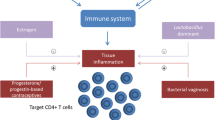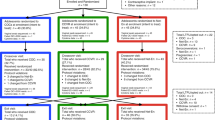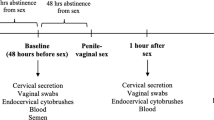Abstract
Hormonal contraceptives may influence the immunological and microbiological milieu of the vagina and alter the risk of acquisition of sexually transmitted infections (STIs) and human immunodeficiency virus (HIV). Most studies demonstrate more normal vaginal flora and less bacterial vaginosis in hormonal contraceptive users compared to non-users, suggesting that contraceptive-induced alteration in vaginal microbiota is an unlikely mechanism for increased risk of STI/HIV acquisition. Measured impacts of hormonal contraceptive use on the presence and activity of vaginal immune cells and vaginal cytokine secretion varies depending on the experimental model, progestogen used, contraceptive delivery method, and length of use of the method, limiting cohesive conclusions. Further study is needed to evaluate the effects of specific progestogens, delivery methods, and long-term use of contraceptives, particularly intrauterine devices and implants, on innate and adaptive immune cells and function in order to ultimately understand impacts on susceptibility to sexually transmitted infections including HIV.
Similar content being viewed by others
References
Papers of particular interest, published recently, have been highlighted as: • Of importance
Wira CR, Rodriguez-Garcia M, Patel MV. The role of sex hormones in immune protection of the female reproductive tract. Nat Rev Immunol. 2015;15(4):217–30. doi:10.1038/nri3819.
Murphy K, Irvin SC, Herold BC. Research gaps in defining the biological link between HIV risk and hormonal contraception. Am J Reprod Immunol. 2014;72(2):228–35. doi:10.1111/aji.12209.
Beagley KW, Gockel CM. Regulation of innate and adaptive immunity by the female sex hormones oestradiol and progesterone. FEMS Immunol Med Microbiol. 2003;38(1):13–22.
Sonnex C. Influence of ovarian hormones on urogenital infection. Sex Transm Infect. 1998;74(1):11–9.
Martin Jr HL, Nyange PM, Richardson BA, Lavreys L, Mandaliya K, Jackson DJ, et al. Hormonal contraception, sexually transmitted diseases, and risk of heterosexual transmission of human immunodeficiency virus type 1. J Infect Dis. 1998;178(4):1053–9.
Baeten JM, Nyange PM, Richardson BA, Lavreys L, Chohan B, Martin Jr HL, et al. Hormonal contraception and risk of sexually transmitted disease acquisition: results from a prospective study. Am J Obstet Gynecol. 2001;185(2):380–5. doi:10.1067/mob.2001.115862.
Polis CB, Phillips SJ, Curtis KM, Westreich DJ, Steyn PS, Raymond E, et al. Hormonal contraceptive methods and risk of HIV acquisition in women: a systematic review of epidemiological evidence. Contraception. 2014;90(4):360–90. doi:10.1016/j.contraception.2014.07.009.
Ralph LJ, McCoy SI, Shiu K, Padian NS. Hormonal contraceptive use and women’s risk of HIV acquisition: a meta-analysis of observational studies. Lancet Infect Dis. 2015;15(2):181–9. doi:10.1016/S1473-3099(14)71052-7.
Noguchi LM, Richardson BA, Baeten JM, Hillier SL, Balkus JE, Chirenje ZM, et al. Risk of HIV-1 acquisition among women who use different types of injectable progestin contraception in South Africa: a prospective cohort study. Lancet HIV. 2015;2(7):e279–87. doi:10.1016/S2352-3018(15)00058-2. Demonstrated lower risk of HIV-1 acquisition in women using NET-EN than DMPA.
Morrison CS, Chen PL, Kwok C, Richardson BA, Chipato T, Mugerwa R, et al. Hormonal contraception and HIV acquisition: reanalysis using marginal structural modeling. AIDS. 2010;24(11):1778–81. doi:10.1097/QAD.0b013e32833a2537.
Ward H, Ronn M. Contribution of sexually transmitted infections to the sexual transmission of HIV. Curr Opin HIV AIDS. 2010;5(4):305–10. doi:10.1097/COH.0b013e32833a8844.
Witkin SS. The vaginal microbiome, vaginal anti-microbial defence mechanisms and the clinical challenge of reducing infection-related preterm birth. BJOG : Int J Obstet Gynaecol. 2015;122(2):213–8. doi:10.1111/1471-0528.13115.
Sirota I, Zarek SM, Segars JH. Potential influence of the microbiome on infertility and assisted reproductive technology. Semin Reprod Med. 2014;32(1):35–42. doi:10.1055/s-0033-1361821.
van de Wijgert JH, Borgdorff H, Verhelst R, Crucitti T, Francis S, Verstraelen H, et al. The vaginal microbiota: what have we learned after a decade of molecular characterization? PLoS One. 2014;9(8), e105998. doi:10.1371/journal.pone.0105998.
Brotman RM. Vaginal microbiome and sexually transmitted infections: an epidemiologic perspective. J Clin Invest. 2011;121(12):4610–7. doi:10.1172/JCI57172.
Cone RA. Vaginal microbiota and sexually transmitted infections that may influence transmission of cell-associated HIV. J Infect Dis. 2014;210 Suppl 3:S616–21. doi:10.1093/infdis/jiu459.
Hickey RJ, Zhou X, Pierson JD, Ravel J, Forney LJ. Understanding vaginal microbiome complexity from an ecological perspective. Transl Res : J Lab Clin Med. 2012;160(4):267–82. doi:10.1016/j.trsl.2012.02.008.
Boskey ER, Cone RA, Whaley KJ, Moench TR. Origins of vaginal acidity: high D/L lactate ratio is consistent with bacteria being the primary source. Hum Reprod. 2001;16(9):1809–13.
Boskey ER, Telsch KM, Whaley KJ, Moench TR, Cone RA. Acid production by vaginal flora in vitro is consistent with the rate and extent of vaginal acidification. Infect Immun. 1999;67(10):5170–5.
Mirmonsef P, Modur S, Burgad D, Gilbert D, Golub ET, French AL, et al. Exploratory comparison of vaginal glycogen and Lactobacillus levels in premenopausal and postmenopausal women. Menopause. 2015;22(7):702–9. doi:10.1097/GME.0000000000000397.
Jespers V, Menten J, Smet H, Poradosu S, Abdellati S, Verhelst R, et al. Quantification of bacterial species of the vaginal microbiome in different groups of women, using nucleic acid amplification tests. BMC Microbiol. 2012;12:83. doi:10.1186/1471-2180-12-83.
Srinivasan S, Liu C, Mitchell CM, Fiedler TL, Thomas KK, Agnew KJ, et al. Temporal variability of human vaginal bacteria and relationship with bacterial vaginosis. PLoS One. 2010;5(4), e10197. doi:10.1371/journal.pone.0010197.
Brotman RM, Shardell MD, Gajer P, Tracy JK, Zenilman JM, Ravel J, et al. Interplay between the temporal dynamics of the vaginal microbiota and human papillomavirus detection. J Infect Dis. 2014;210(11):1723–33. doi:10.1093/infdis/jiu330.
Bradshaw CS, Vodstrcil LA, Hocking JS, Law M, Pirotta M, Garland SM, et al. Recurrence of bacterial vaginosis is significantly associated with posttreatment sexual activities and hormonal contraceptive use. Clin Infect Dis. 2013;56(6):777–86. doi:10.1093/cid/cis1030.
Calzolari E, Masciangelo R, Milite V, Verteramo R. Bacterial vaginosis and contraceptive methods. Int J Gynecol Obstet. 2000;70(3):341–6. doi:10.1016/s0020-7292(00)00217-4.
Rifkin SB, Smith MR, Brotman RM, Gindi RM, Erbelding EJ. Hormonal contraception and risk of bacterial vaginosis diagnosis in an observational study of women attending STD clinics in Baltimore. MD Contracept. 2009;80(1):63–7. doi:10.1016/j.contraception.2009.01.008.
Holzman C, Leventhal JM, Qiu H, Jones NM, Wang J, Grp BVS. Factors linked to bacterial vaginosis in nonpregnant women. Am J Public Health. 2001;91(10):1664–70. doi:10.2105/ajph.91.10.1664.
Riggs M, Klebanoff M, Nansel T, Zhang J, Schwebke J, Andrews W. Longitudinal association between hormonal contraceptives and bacterial vaginosis in women of reproductive age. Sex Transm Dis. 2007;34(12):954–9. doi:10.1097/OLQ.0b013e31811ed0e4.
Mitchell CM, McLemore L, Westerberg K, Astronomo R, Smythe K, Gardella C, et al. Long-term effect of depot medroxyprogesterone acetate on vaginal microbiota, epithelial thickness and HIV target cells. J Infect Dis. 2014;210(4):651–5. doi:10.1093/infdis/jiu176.
Shoubnikova M, Hellberg D, Nilsson S, Mardh PA. Contraceptive use in women with bacterial vaginosis. Contraception. 1997;55(6):355–8. doi:10.1016/s0010-7824(97)00044-9.
Madden T, Grentzer JM, Secura GM, Allsworth JE, Peipert JF. Risk of bacterial vaginosis in users of the intrauterine device: a longitudinal study. Sex Transm Dis. 2012;39(3):217–22. doi:10.1097/OLQ.0b013e31823e68fe.
Jacobson JC, Turok DK, Dermish AI, Nygaard IE, Settles ML. Vaginal microbiome changes with levonorgestrel intrauterine system placement. Contraception. 2014;90(2):130–5. doi:10.1016/j.contraception.2014.04.006.
Veres S, Miller L, Burington B. A comparison between the vaginal ring and oral contraceptives. Obstet Gynecol. 2004;104(3):555–63. doi:10.1097/01.AOG.0000136082.59644.13.
De Seta F, Restaino S, De Santo D, Stabile G, Banco R, Busetti M, et al. Effects of hormonal contraception on vaginal flora. Contraception. 2012;86(5):526–9. doi:10.1016/j.contraception.2012.02.012.
Gunawardana M, Moss JA, Smith TJ, Kennedy S, Kopin E, Nguyen C, et al. Microbial biofilms on the surface of intravaginal rings worn in non-human primates. J Med Microbiol. 2011;60(Pt 6):828–37. doi:10.1099/jmm.0.028225-0.
Huang Y, Merkatz RB, Hillier SL, Roberts K, Blithe DL, Sitruk-Ware R, et al. Effects of a one year reusable contraceptive vaginal ring on vaginal microflora and the risk of vaginal infection: an open-label prospective evaluation. PLoS One. 2015;10(8), e0134460. doi:10.1371/journal.pone.0134460.
van de Wijgert JH, Verwijs MC, Turner AN, Morrison CS. Hormonal contraception decreases bacterial vaginosis but oral contraception may increase candidiasis: implications for HIV transmission. AIDS. 2013;27(13):2141–53. doi:10.1097/QAD.0b013e32836290b6. This meta-analysis of 36 studies estimated a 10–20% reduction in BV in combined oral contraceptive uses and 18–30% reduction in BV in DMPA users.
Vodstrcil LA, Hocking JS, Law M, Walker S, Tabrizi SN, Fairley CK, et al. Hormonal contraception is associated with a reduced risk of bacterial vaginosis: a systematic review and meta-analysis. PLoS One. 2013;8(9):e73055. doi:10.1371/journal.pone.0073055. This meta-analysis of 55 studies estimated a 25% reduction in incident and prevalent bacterial vaginosis in hormonal contraceptive users compared to non-users.
Nalbandian G, Kovats S. Understanding sex biases in immunity: effects of estrogen on the differentiation and function of antigen-presenting cells. Immunol Res. 2005;31(2):91–106. doi:10.1385/IR:31:2:091.
Tan IJ, Peeva E, Zandman-Goddard G. Hormonal modulation of the immune system—a spotlight on the role of progestogens. Autoimmun Rev. 2015;14(6):536–42. doi:10.1016/j.autrev.2015.02.004.
Guleria I, Sayegh MH. Maternal acceptance of the fetus: true human tolerance. J Immunol. 2007;178(6):3345–51.
Rodriguez-Garcia M, Patel MV, Wira CR. Innate and adaptive anti-HIV immune responses in the female reproductive tract. J Reprod Immunol. 2013;97(1):74–84. doi:10.1016/j.jri.2012.10.010.
Tuffrey M, Taylorrobinson D. Progesterone as a key factor in the development of a mouse model for genital-tract infection with chlamydia-trachomatis. Fems Microbiol Lett. 1981;12(2):111–5.
Parr MB, Kepple L, McDermott MR, Drew MD, Bozzola JJ, Parr EL. A mouse model for studies of mucosal immunity to vaginal infection by herpes-simplex virus type-2. Lab Invest. 1994;70(3):369–80.
Abel K, Rourke T, Lu D, Bost K, McChesney MB, Miller CJ. Abrogation of attenuated lentivirus-induced protection in rhesus macaques by administration of depo-provera before intravaginal challenge with simian immunodeficiency virus mac239. J Infect Dis. 2004;190(9):1697–705. doi:10.1086/424600.
Hild-Petito S, Veazey RS, Larner JM, Reel JR, Blye RP. Effects of two progestin-only contraceptives, Depo-Provera and Norplant-II, on the vaginal epithelium of rhesus monkeys. Aids Res Hum Retrovir. 1998;14:S125–30.
Chandra N, Thurman AR, Anderson S, Cunningham TD, Yousefieh N, Mauck C, et al. Depot medroxyprogesterone acetate increases immune cell numbers and activation markers in human vaginal mucosal tissues. Aids Res Hum Retrovir. 2013;29(3):592–601. doi:10.1089/aid.2012.0271.
Bahamondes L, Trevisan M, Andrade L, Marchi NM, Castro S, Diaz J, et al. The effect upon the human vaginal histology of the long-term use of the injectable contraceptive Depo-Provera. Contraception. 2000;62(1):23–7.
Bahamondes MV, Castro S, Marchi NM, Marcovici M, Andrade LA, Fernandes A, et al. Human vaginal histology in long-term users of the injectable contraceptive depot-medroxyprogesterone acetate. Contraception. 2014;90(2):117–22. doi:10.1016/j.contraception.2014.01.024.
Mauck CK, Callahan MM, Baker J, Arbogast K, Veazey R, Stock R, et al. The effect of one injection of Depo-Provera on the human vaginal epithelium and cervical ectopy. Contraception. 1999;60(1):15–24.
Miller L, Patton DL, Meier A, Thwin SS, Hooton TM, Eschenbach DA. Depomedroxyprogesterone-induced hypoestrogenism and changes in vaginal flora and epithelium. Obstet Gynecol. 2000;96(3):431–9.
Chappell CA, Rohan LC, Moncla BJ, Wang L, Meyn LA, Bunge K, et al. The effects of reproductive hormones on the physical properties of cervicovaginal fluid. Am J Obstet Gynecol. 2014;211(3):226 e1–7. doi:10.1016/j.ajog.2014.03.041.
Wang L, Koppolu S, Chappell C, Moncla BJ, Hillier SL, Mahal LK. Studying the effects of reproductive hormones and bacterial vaginosis on the glycome of lavage samples from the cervicovaginal cavity. PLoS One. 2015;10(5), e0127021. doi:10.1371/journal.pone.0127021.
Shukair SA, Allen SA, Cianci GC, Stieh DJ, Anderson MR, Baig SM, et al. Human cervicovaginal mucus contains an activity that hinders HIV-1 movement. Mucosal Immunol. 2013;6(2):427–34. doi:10.1038/mi.2012.87.
Boukari H, Brichacek B, Stratton P, Mahoney SF, Lifson JD, Margolis L, et al. Movements of HIV-virions in human cervical mucus. Biomacromolecules. 2009;10(9):2482–8. doi:10.1021/bm900344q.
Zou G, Ochiai H, Huang W, Yang Q, Li C, Wang LX. Chemoenzymatic synthesis and Fcgamma receptor binding of homogeneous glycoforms of antibody Fc domain. Presence of a bisecting sugar moiety enhances the affinity of Fc to FcgammaIIIa receptor. J Am Chem Soc. 2011;133(46):18975–91. doi:10.1021/ja208390n.
Moncla BJ, Chappell CA, Mahal LK, Debo BM, Meyn LA, Hillier SL. Impact of bacterial vaginosis, as assessed by nugent criteria and hormonal status on glycosidases and lectin binding in cervicovaginal lavage samples. PLoS One. 2015;10(5), e0127091. doi:10.1371/journal.pone.0127091.
Chappell CA, Isaacs CE, Xu W, Meyn LA, Uranker K, Dezzutti CS, et al. The effect of menopause on the innate antiviral activity of cervicovaginal lavage. Am J Obstet Gynecol. 2015;213(2):204 e1–6. doi:10.1016/j.ajog.2015.03.045.
Masson L, Mlisana K, Little F, Werner L, Mkhize NN, Ronacher K, et al. Defining genital tract cytokine signatures of sexually transmitted infections and bacterial vaginosis in women at high risk of HIV infection: a cross-sectional study. Sex Transm Infect. 2014;90(8):580–7. doi:10.1136/sextrans-2014-051601.
Thurman AR, Kimble T, Herold B, Mesquita PM, Fichorova RN, Dawood HY, et al. Bacterial vaginosis and subclinical markers of genital tract inflammation and mucosal immunity. Aids Res Hum Retrovir. 2015. doi:10.1089/aid.2015.0006.
Morrison C, Fichorova RN, Mauck C, Chen PL, Kwok C, Chipato T, et al. Cervical inflammation and immunity associated with hormonal contraception, pregnancy, and HIV-1 seroconversion. J Acquir Immune Defic Syndr. 2014;66(2):109–17. doi:10.1097/QAI.0000000000000103. A nested case control study of hormonal contraceptive users showed that higher cervicovaginal fluid RANTES levels and lower SLPI levels were associated with HIV seroconversion, and that higher cervicovaginal RANTES levels were seen in DMPA users.
Caux C, Ait-Yahia S, Chemin K, de Bouteiller O, Dieu-Nosjean MC, Homey B, et al. Dendritic cell biology and regulation of dendritic cell trafficking by chemokines. Springer Semin Immunopathol. 2000;22(4):345–69.
Wahl SM, McNeely TB, Janoff EN, Shugars D, Worley P, Tucker C, et al. Secretory leukocyte protease inhibitor (SLPI) in mucosal fluids inhibits HIV-I. Oral Dis. 1997;3 Suppl 1:S64–9.
Deese J, Masson L, Miller W, Cohen M, Morrison C, Wang M, et al. Injectable progestin-only contraception is associated with increased levels of pro-inflammatory cytokines in the female genital tract. Am J Reprod Immunol. 2015;74(4):357–67. doi:10.1111/aji.12415.
Govender Y, Avenant C, Verhoog NJ, Ray RM, Grantham NJ, Africander D, et al. The injectable-only contraceptive medroxyprogesterone acetate, unlike norethisterone acetate and progesterone, regulates inflammatory genes in endocervical cells via the glucocorticoid receptor. PLoS One. 2014;9(5), e96497. doi:10.1371/journal.pone.0096497.
Michel KG, Huijbregts RP, Gleason JL, Richter HE, Hel Z. Effect of hormonal contraception on the function of plasmacytoid dendritic cells and distribution of immune cell populations in the female reproductive tract. J Acquir Immune Defic Syndr. 2015;68(5):511–8. doi:10.1097/QAI.0000000000000531.
Guthrie BL, Introini A, Roxby AC, Choi RY, Bosire R, Lohman-Payne B, et al. Depot medroxyprogesterone acetate use is associated with elevated innate immune effector molecules in cervicovaginal secretions of HIV-1-uninfected women. J Acquir Immune Defic Syndr. 2015;69(1):1–10. doi:10.1097/QAI.0000000000000533.
Huijbregts RPH, Helton ES, Michel KG, Sabbaj S, Richter HE, Goepfert PA, et al. Hormonal contraception and HIV-1 Infection: medroxyprogesterone acetate suppresses innate and adaptive immune mechanisms. Endocrinology. 2013;154(3):1282–95. doi:10.1210/en.2012-1850.
Achilles SL, Creinin MD, Stoner KA, Chen BA, Meyn L, Hillier SL. Changes in genital tract immune cell populations after initiation of intrauterine contraception. Am J Obstet Gynecol. 2014;211(5):489 e1–9. doi:10.1016/j.ajog.2014.05.016.
Coleman JS, Mwachari C, Balkus J, Sanguli L, Muliro A, Agnew K, et al. Effect of the levonorgestrel intrauterine device on genital HIV-1 RNA shedding among HIV-1-infected women not taking antiretroviral therapy in Nairobi. Kenya J Acquir Immune Defic Syndr. 2013;63(2):245–8. doi:10.1097/QAI.0b013e31828decf8.
Ngcapu S, Masson L, Sibeko S, Werner L, McKinnon LR, Mlisana K, et al. Lower concentrations of chemotactic cytokines and soluble innate factors in the lower female genital tract associated with the use of injectable hormonal contraceptive. J Reprod Immunol. 2015;110:14–21. doi:10.1016/j.jri.2015.03.007.
Huijbregts RP, Michel KG, Hel Z. Effect of progestins on immunity: medroxyprogesterone but not norethisterone or levonorgestrel suppresses the function of T cells and pDCs. Contraception. 2014;90(2):123–9. doi:10.1016/j.contraception.2014.02.006.
Tomasicchio M, Avenant C, Du Toit A, Ray RM, Hapgood JP. The progestin-only contraceptive medroxyprogesterone acetate, but not norethisterone acetate, enhances HIV-1 Vpr-mediated apoptosis in human CD4+ T cells through the glucocorticoid receptor. PLoS One. 2013;8(5), e62895. doi:10.1371/journal.pone.0062895.
Cates W. The Evidence for Contraceptive Options and HIV Outcomes Trial (ECHO). Clinicaltrials.gov. 2015. https://clinicaltrials.gov/ct2/show/NCT02550067. Accessed 26 Oct 2015.
Acknowledgments
This study was supported by the US National Institutes of Health/National Institute of Allergy and Infectious Diseases grant support (NIH R01-AI102835)
Author information
Authors and Affiliations
Corresponding author
Ethics declarations
Conflict of Interest
Jessica Tarleton declares that she has no competing interests.
Lisa Haddad declares personal fees for working as a consultant on a medical advisory panel for Pfizer Pharmaceutical.
Sharon L. Achilles declares personal fees for consultant work for Merck Sharp & Dohme Corp.
Human and Animal Rights and Informed Consent
This article does not contain any studies with human or animal subjects performed by any of the authors.
Additional information
This article is part of the Topical Collection on Family Planning
Rights and permissions
About this article
Cite this article
Tarleton, J., Haddad, L. & Achilles, S.L. Hormonal Contraceptive Effects on the Vaginal Milieu: Microbiota and Immunity. Curr Obstet Gynecol Rep 5, 20–29 (2016). https://doi.org/10.1007/s13669-016-0142-6
Published:
Issue Date:
DOI: https://doi.org/10.1007/s13669-016-0142-6




